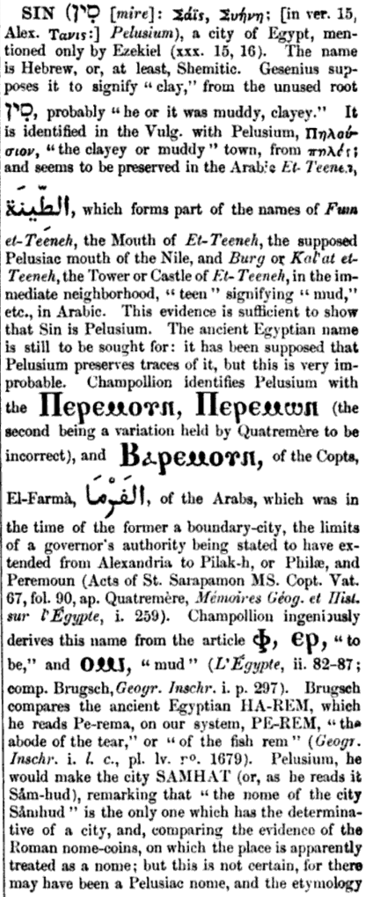|
Other Archaeological Sites / The Neolithic of the Levant (500 Page Book Online) Pelusium (Sin)
Page 328-9 in A Handbook for Travellers in Lower and Upper Egypt -- Part II by John Murray (Firm ) 1880 ... Salaheeyeh was probably either Tacasarta or Sile of the Itinerary of Antoninus. One of the roads is more direct than this and leaves Salaheeyeh considerably to the left. Several mounds of ancient towns are seen in the distance; among them Tel Defenneh, which marks the site of Daphne, the Tehaphnehes or Tahpanhes of the Bible, a fortified outpost of Pelusium, and distant from it 16 Roman miles. At Tahpanhes the Egyptian king is said by Jeremiah to have had a palace (Jeremia xliii 9).
Take in thy hand great stones, and thou hast hidden them, in the clay, in the brick-kiln, that [is] at the Tahpanhes --- known by the Ancient Greeks as the Pelusiac [outlet of the Nile] Daphnae of Herodotos (3) --- was a city on the eastern frontier of Lower Egypt, represented today by Tell Defenneh, a desert mound lying some 20 miles Southwest from Pelusium (Biblical "Sin") and a little North of the modern Al-Kantarah ("the bridge"), marking the old caravan route from Egypt to Palestine -- Mesopotamia and Assyria (1) (2).
Kantarah (see Page 306) (4) Page 3047-8 in Dr. William Smith's Dictionary of the Bible Volume IV (1888)
(1) Tahpanhes --- WikiPedia
(2) Tahpanhes in the International Standard Bible Encyclopedia (ISBE)
(3) Page 50 in Ten Years' Digging in Egypt by William Matthew Flinders Petrie (1886)
(4) Dr. William Smith's Dictionary of the Bible Volume IV (1888)
|



